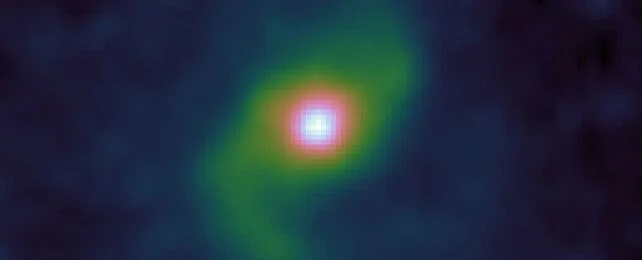
Monster Galaxy from Early Universe Defies Expectations with Milky Way-Like Structure
In a groundbreaking discovery that challenges conventional theories of galaxy formation, astronomers have observed a colossal barred spiral galaxy, dubbed J0107a, dating back 11.1 billion years. This monster galaxy, existing when the universe was merely a fifth of its current age, exhibits a striking resemblance to our own Milky Way, yet boasts significantly larger mass and star formation activity. This observation, combining the power of the Atacama Large Millimeter/submillimeter Array (ALMA) and NASA's James Webb Space Telescope, offers unprecedented insights into the evolution of galaxies in the early universe.

J0107a challenges the prevailing assumption that early galaxies were primarily turbulent and irregular. Shuo Huang of the National Astronomical Observatory of Japan, lead author of the study published in Nature, emphasizes the galaxy's exceptional characteristics: "The galaxy is a monster galaxy with a high star formation rate and plenty of gas, much more than present-day galaxies." What makes this discovery truly remarkable is that, unlike other galaxies undergoing intense star formation driven by collisions or mergers, J0107a shows no signs of such disturbances.
The James Webb Space Telescope near-infrared images revealed J0107a is an exceptionally massive example of a monster galaxy, with a mass more than ten times that of the Milky Way and a star formation rate approximately 300 times that of the Milky Way.
Astronomers observed the emission lines of carbon monoxide and neutral carbon atoms and found that J0107a closely resembles modern barred spiral galaxies, such as the Milky Way, in terms of bar structure as well as distribution and movement of the associated gas. The data shows that J0107a's bar structure, which consists of stars and gas with a mass far greater than that of modern galaxies, stirs up the disk, creating a gas flow at a speed of several hundred kilometers per second over a radius of 20,000 light years around the center of the galaxy, which is equivalent to the distance from the center of the Milky Way to the solar system.
The bar that is part of J0107a measures about 50,000 light years in length.
Toshiki Saito, an astronomer at Shizuoka University in Japan, highlights the crucial question this discovery poses: "How did such a massive galaxy form in such an early universe?" This observation compels a re-evaluation of existing theories surrounding galaxy formation in the early universe.
This study represents **the first successful direct observation of a burst of star formation induced by gas inflow from a bar structure in the early universe**. No previous theoretical studies of galaxy formation predicted the existence of a monster galaxy with such a bar structure.
The team found that the proportion of gas in the bar structure of a modern galaxy is less than 10% of the total mass, that of J0107a is very high at around 50%.

The existence of J0107a prompts a significant question: How common were such well-structured, massive galaxies in the early universe? Further studies are needed to determine whether J0107a is an exceptional case or representative of a previously underestimated population of early galaxies. This finding underscores the transformative power of the James Webb Space Telescope in unveiling the mysteries of the early cosmos and rewriting our understanding of how galaxies like our own Milky Way came to be.
What are your thoughts on this surprising discovery? Share your insights and theories in the comments below!